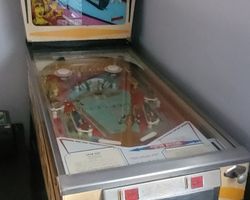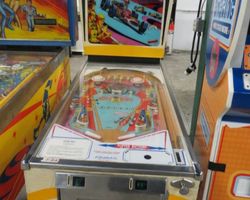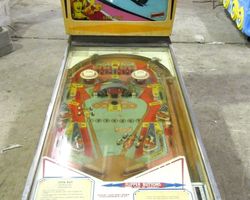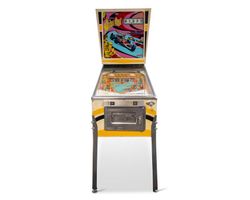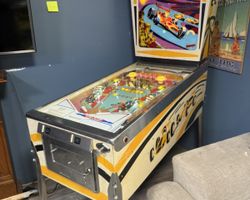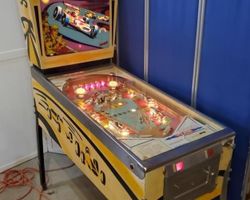Spin Out
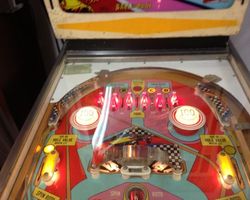
Average Prices: USD $300 to $900
Produced: July, 1975
Production Run: 2,850 units
Machine Type: Electro-mechanical
Players: 1
Design by: Ed Krynski
Art by: Gordon Morison
The D. Gottlieb & Co. release, "Spin Out," from July 1975, represents a distinct chapter in the electro-mechanical (EM) era of pinball machines. At a time when solid-state technology was on the horizon, Gottlieb continued to refine its proven EM designs, and "Spin Out" stands as a testament to that commitment. With a production run totaling 2,962 units, a figure that includes 112 sample games identified from the meticulous handwritten documentation of Gottlieb draftsman Bob Malvasio, "Spin Out" had a considerable presence in arcades and amusement locations.
The machine's creation involved the seasoned talents of Ed Krynski, responsible for the game's design, and Gordon Morison, who brought the vibrant auto racing theme to life through his artwork. The racing theme itself was a popular choice in the mid-1970s, resonating with a public captivated by high-speed competition. Morison’s artistic contribution is evident in the machine's colorful art package, from the cabinet to the backglass, providing an immediate visual draw. The machine adheres to Gottlieb’s characteristic "wedge head" cabinet design, a familiar form for collectors and players of the era.
"Spin Out" is defined by its central roto-target, a unique mechanism that serves as the heart of the game's interaction. This spinning target features numbers from 1 to 7, with the objective being to hit specific numbers to light corresponding inserts on the playfield. The roto-target is not merely a spinning disc; it integrates into the game's core scoring strategy. Another distinguishing visual element is the half-moon credit window, a subtle design flourish typical of Gottlieb machines from this period. Beyond these unique attributes, "Spin Out" features a standard yet effective setup of two pop bumpers, two slingshots, and a single kick-out hole. The implementation of 3-inch flippers was a practical design choice, offering players more control and making shots generally easier than machines equipped with smaller, 2-inch flippers common in earlier designs. This larger flipper size contributed to a more fluid and engaging ball control experience.
The playfield of "Spin Out" is dominated by the strategic placement of its central roto-target. This large, rotating disc sits prominently, drawing immediate player focus. Surrounding elements include two pop bumpers that provide kinetic energy and score opportunities, while the slingshots offer reactive rebounds to errant balls. At the top of the playfield, a series of "a,b,c,d" rollovers are integrated, contributing to scoring and game progression. A central saucer acts as a distinct shot target, though it carries a reputation for being a high-risk area, often leading to immediate drains if shots are not precise.
The design philosophy of "Spin Out" leans towards a precision-oriented experience rather than a chaotic, multi-ramped layout. The game encourages a "thinking player" approach, where strategic aiming at the roto-target is paramount. The artwork throughout the playfield maintains Gordon Morison’s consistent, colorful racing theme, with racing motifs and imagery tying into the overall aesthetic. Lighting elements are integral to the gameplay, as hitting numbers on the roto-target illuminates corresponding numbered inserts on the playfield, providing clear visual feedback on player progress towards awards. This feedback loop guides the player’s strategy, emphasizing which numbers are still needed.
The core gameplay of "Spin Out" revolves around hitting the rotating target to collect numbers from 1 through 7. The progression system is built around these collected numbers: achieving four adjacent lit numbers on the playfield instantly awards one replay. This creates a dynamic challenge, as players must not only hit the roto-target but also aim for specific unlit numbers to complete sequences. The single instance of the number "4" on the roto-target introduces a critical strategic element. Hitting the "4" last in a sequence of collected numbers triggers a unique "egg" feature, which can award multiple replays and engage the knocker, providing a significant bonus and a memorable sound. This particular objective adds considerable depth to the game, prompting players to manage ball control and shot timing to secure this high-value target. Strategies often involve precision aiming at the roto-target to complete number sequences efficiently, while simultaneously navigating the hazards of the playfield, such as the often-perilous central saucer. The game’s scoring system rewards consistent roto-target hits, triggering pop bumpers, and making accurate shots to the a,b,c,d rollovers. When optimally tuned, "Spin Out" can deliver a fast-paced experience that demands accurate flipper work and strategic thinking.
Reception of "Spin Out" within the pinball community has been diverse, though leaning towards a positive appraisal when considering its design intent. Its central roto-target is frequently highlighted as a standout and engaging feature, with players enjoying the challenge of precision aiming to collect numbers and pursue the high-value "4" shot. The racing theme and Gordon Morison's artwork consistently receive praise, with many noting the cabinet and backglass as visually appealing and vibrant. For an EM machine, "Spin Out" is often described as offering a surprising amount of strategic depth, moving beyond mere randomness to become a "thinking player’s game" that rewards careful shot selection and an understanding of the number progression. This layered gameplay contributes to its perceived replayability, encouraging players to return and refine their strategies. Furthermore, when properly set up and maintained, with clean playfields and fresh rubbers, the machine can play with a satisfying speed and responsiveness. The "egg" feature, tied to the "4" shot and its multi-replay awards, is recognized as a cool and distinctive element for an EM era game.
However, "Spin Out" is not without its detractors. Some players find the gameplay to be less varied, feeling that the reliance on the central roto-target can lead to a repetitive experience, describing the playfield as somewhat "bare" or having "limited shots." The central saucer is a common point of contention, frequently cited as "unbelievably dangerous" due to its propensity to drain balls. While the roto-target is largely praised, some have expressed that its implementation, while unique, doesn't always feel revolutionary compared to earlier spinning target designs, and that shots to it can sometimes be frustrating or result in undesired ball paths. A minority view finds the artwork less captivating than others, describing it as "average" or "plainer." A critical consensus points out that the machine's enjoyment is highly dependent on its condition and setup; a poorly maintained "Spin Out" can indeed be a less engaging experience. Despite these criticisms, "Spin Out" holds a significant place as a quintessential Gottlieb EM, showcasing the company's design philosophy of creating games with a strong central mechanic that requires skill and strategy. It stands as an example of EM design evolution, particularly with its 3-inch flippers offering improved playability, and its unique scoring nuances influenced subsequent game designers to explore varied objectives beyond mere point accumulation. Its legacy is that of a machine that, when understood and appreciated for its unique strategic depth, delivers a rewarding pinball experience from the latter half of the EM era.
Sponsored Links
 Ebay Listings
Ebay Listings
 Auction Results
Auction Results
| Cost | Location | Date |
|---|---|---|
| USD $500 |  Florida, United States Florida, United States |
23 August, 2025 |
| USD $2,600 |  United States United States |
02 April, 2025 |
| USD $500 |  New York, United States New York, United States |
04 February, 2025 |
| CAD $380 |  Canada Canada |
13 November, 2024 |
| USD $1,100 |  California, United States California, United States |
12 August, 2023 |
| GBP £250 |  United Kingdom United Kingdom |
20 July, 2023 |
| USD $650 |  New York, United States New York, United States |
21 May, 2023 |
| GBP £680 |  United Kingdom United Kingdom |
24 February, 2023 |
| USD $643 |  Alabama, United States Alabama, United States |
22 January, 2023 |
| USD $3,250 |  Texas, United States Texas, United States |
22 September, 2022 |


Private Policy · Search Website · Contact Us
As an eBay Partner, we may earn a commission from qualifying purchases made through links on this site, at no additional cost to you.
All trademarks and copyrighted materials remain property of their respective owners. All other content copyright 2007 - 2025 Pinpedia.

